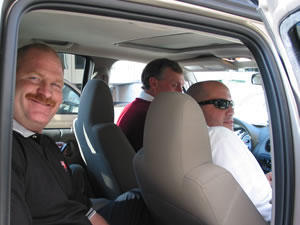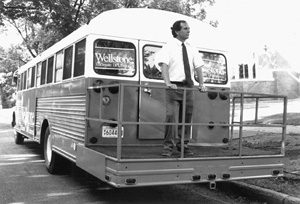Cover of Rolling Stone????
October 13th, 2005
Naaaaaaaaaaaaaaaaaaaah…
But I did make Time Magazine! Thanks to Griff for letting me know!
Sun setting on turbine installation a tadbit north and east of Owatonna.
One alternative-energy source finally makes economic sense, but try telling that to the neighbors
By UNMESH KHER, MARC HEQUET/ OCEANA COUNTYSuffering from migraines and sick of suburban life, real estate agent Dawn Deel fled the outskirts of Detroit three years ago to build a new life in Golden Township, Oceana County, on Lake Michigan’s eastern shore. Deel’s new house, in an area known for the beauty of its sand-duned beaches and orchard-clad hills, overlooks a fallow field where cherry trees once grew. She hopes this bucolic vista will lure buyers to the adjacent plots she owns. Best of all, her migraines are gone. “Since I’ve been up here,” she says, “my whole physiology has changed.” Deel, however, now has a different sort of headache. Alternative-energy companies Michigan Wind Energy and Mackinaw Power plan to build dozens of wind turbines–290-ft.-tall white steel pinwheels–across the county. Some may stand just a quarter-mile from Deel’s new house, and she believes that their looming presence will erode the value of her property. She and her neighbors will ask the township this week for a six-month moratorium to reconsider its role in Michigan’s largest wind-energy project.
But Deel’s neighbor Ron Longcore, 66, a burly, gruff orchardist and Oceana County lifer, wants to lease a sliver of his land to house some of Michigan Wind Energy’s turbines. The money, he says, would help cover taxes and insurance on his orchards, averting the need to parcel off parts of the property to residential developers. “I’d rather see one or two towers sitting out there than a bunch of houses,” says Longcore. “I want to preserve my way of life.”
Opposition to wind power used to come mostly from wildlife enthusiasts, who are concerned about the birds and bats windmills kill. But the battle these days focuses on something much more primal: money. Ranchers and farmers like Longcore across the U.S.–and, for that matter, much of Europe–can earn extra income by leasing out their land for turbines. But as pollution-free wind farms proliferate from California to northern Germany, a trend driven by tax breaks and international concern about global warming, homeowners are worried about the effects on real estate values. “Resistance to wind turbines is inversely proportional to the distance between the individual turbine and the nearest McMansion,” says Carol Overland, a Northfield, Minn., attorney who works on wind issues.
The winds of fortune have lately favored people like Longcore because the economics finally make sense. Although wind accounts for only 0.5% of all the power generated in the U.S., a federal tax subsidy of 1.8¢ a kilowatt-hour (kW-h) has made it the nation’s fastest-growing source of electrical power. The country had the capacity to generate 6,700 megawatts (MW) of wind-generated electricity last year, up from 2,500 MW in 2000. That’s enough to electrify 1.6 million households annually, the equivalent of burning 9 million tons of coal. At 3¢ to 7¢ per kW-h, it is competitively priced as well, costing about the same as power generated from natural gas. Meanwhile, California, New York and 18 other states have passed laws promoting renewable energy that are sure to boost investment in wind.
Many European countries are way ahead of the U.S. on the wind front. Germany alone produces more than a third of the world’s 47 MW of wind energy. This June, when a wind farm in Ceredigion, Wales, came online, Britain became one of eight nations producing more than 1 billion watts–or a gigawatt–of wind-generated electricity. “We’re in an exponential growth phase,” says Alison Hill of the British Wind Energy Association. “It has taken us 14 years to get our first gig. It’ll take 14 months to get our second.”
But if wind is gaining force around the world, the opposition is making gains as well. The first offshore wind-power project in the U.S., in Massachusetts’ Nantucket Sound, has met with stiff resistance from well-heeled beachfront residents, including Senator Ted Kennedy. In New York, Tom Golisano, the billionaire founder of Paychex Inc., is leading the fight against a plan to build hundreds of turbines in the west of the state, near the Great Lakes. And an odd alliance of environmentalists, oil and gas interests and ranchers has emerged to legally thwart a wind farm planned for the Flint Hills of Kansas, one of the last pristine tallgrass prairies in the U.S. About 100 local antiwind groups have emerged in Germany, and in France, which has just 440 wind farms but hopes to operate 7,000 by 2010, such groups have banded together to form a national network named Wind of Anger.
Scenery isn’t the only concern. Noise and light pollution often enliven the debate. Kelly Alexander, who lives about 500 yds. from two turbines in northern Michigan, watched his property value drop from $102,000 in 1999 to $96,000 in 2002. The tax assessor’s form attributed the markdown to “noise from two wind generating systems.” Alexander says when the rotors catch the sun at particular angles, a flickering light permeates his house. Indeed, it isn’t easy to sell a house that sits near a turbine. Julie and Bart Thiry of Kewaunee County, Wis., who live in a ranch house 800 ft. away from the nearest of five turbines, believe that the windmills are somehow responsible for the persistent headaches of their 8- and 9-year-old daughters. Bart, a school bus driver and janitor, says when he tried to sell the house, he couldn’t get an offer.
Randall Swisher, executive director of the American Wind Energy Association, says complaints about noise from turbines are grossly exaggerated. “If you ever visit a wind farm,” he says, “you will notice that the wind often makes more noise than the turbine.” Still, Invenergy, the firm that will develop Mackinaw Power’s part of the western Michigan initiative, often pays homeowners who live near its turbines $800 to $1,000 a year in compensation, says Invenergy’s senior development manager, Joel Link. As for the putative threat to scenery posed by towering turbines, wind-power supporters point out that tourists often flock to wind farms. But such arguments aren’t likely to defuse the growing conflict in Oceana County. “People also come to look at train wrecks,” retorts Ted Cuchna, president of a local construction company. “I don’t want a train wreck in my back yard.” In Oceana County, the war over wind has just begun.
The Apple and the Tree
October 11th, 2005
Remember Todd Guerrero, the attorney at Pig, Dog & Duck, (612) 371-3258, the guy with the “Big Stone II” applications? (That’s him hiding from the camera on the passenger side — from a biodiesel convention’s test drive of a Jeep Liberty!) (no, NOT the one at Reference AudioVisual)

Well today his mother’s in the news! I had the joy of meeting her at Women’s Political Alliance ages ago. She’s an eminently sensible woman who frequents the LTE pages. I’ll never understand genetics. Here’s her editorial:
Ironies at St. Thomas Law School
“Law school can be a torturous experience.”
This was the first sentence of the little article in the Oct. 5 Star Tribune announcing the recognition of St. Thomas Law School as the “Best Quality of Life” among students by the Princeton Review in their new book, “The Best 159 Law Schools.”
The irony of your writer to use the word “torturous” was not lost on some of us working to stop torture of detainees in prisons such as Abu Ghraib and Guantanamo and others around the world where prisoners are “rendered” as a result of the wars in Iraq and Afghanistan. Last year St. Thomas Law School hired Robert Delahunty as one of their esteemed professors. This is the man who, when working as a lawyer in the U.S. Department of Justice helped write the memos to Attorney General Alberto Gonzales justifying torture in “certain circumstances.”
The founding dean of the law school, Patrick Schiltz, made an even more ironical statement to your reporter by saying, “We work hard at stressing not just the law but also the way people treat each other. That was an important part of the philosophy in setting up the school.”
While I have no doubt that St. Thomas is a fine law school, as far as I know, torture is against the law — the Geneva Conventions and the Conventions Against Torture and Other Cruel, Inhumane or Degrading Treatment or Punishment. Perhaps the hiring committee did not know this was U.S. law and, also, forgot about the law school’s philosophy in the hiring of Delahunty.
Pat Guerrero, St. Paul.
‘Tis the season of Wellstone…
October 9th, 2005

It’s that time of year again. Yes, my office may be in Northfield, and most everyone I know in Northfield knew Wellstone, but I arrived in town in 1997 and didn’t know Wellstone personally. I only dealt with him directly once, when I tracked him down in a hallway at St. Thomas and handed him a draft of radiation victims legislation being promoted by an attorney cohort in Florida, and just a few days later he was visibly working on it. I was impressed that he was paying attention. On the other hand, I have kept the Red Wing Republican Eagle front page from the fall of 2002, not long before Wellstone’s death, where he and NSP Sen. Steve Murphy were yucking it up and the headline read something on the order of “Keep the plant open” and the focus was on Wellstone’s remarks about keeping Prairie Island nuclear plant open, something that appalled me.
It’s also popular to connect publicly with Wellstone and try to ride on his coat-tails — but that his its limits. I was at the Northfield Library and watched Ray Cox try to explain his support of an amendment to prohibit gay marriage, where Ray misused a quote from Wellstone in which he supported the “Defense of Marriage” bill, and Ray did not disclose Wellstone’s very public heartfelt, humble and horrified recant of his support of that bill after the death of Matthew Shepherd. Thankfully Chuck Von Ruden was there to point out Wellstone’s position and Ray’s misuse of Wellstone.
And of course, Casper (“Lost in Washington“) and Wellstone’s “Powerline” is a holy book to me (Mike Casper has a lot to do with my energy philosophy — I had many great hours with the Caspers going up to Chisago on that transmission project, or going to this or that presentation or workshop or dinner on my deck, ranting and raving about energy issues and doing what we can about it all). If you haven’t read Powerline, there are 13 copies at abebooks.com right now! Drop everything and order it. You’ll see that, as we say in transmission, “It’s all connected.” And sadly, not much has changed, except the bankrolls of a few “players.”
That said, have you seen this article in today’s STrib?
Here’s a quote, a “question” from the reporter:
One theme is the biography is maturation — how Wellstone went from bomb-thrower to a fairly effective legislator. Can you talk more about that?
I don’t recall Wellstone being a “bomb-thrower” of other than the benign verbal variety and I’m wondering… did I miss something? I’ve asked the reporter for substantiation, IF THERE IS ANY. I sent the STrib’s Readers Representative a similar missive. If that’s a metaphor for his firey speech or passionate attitude, words like that ought to be in quotes.
When it rains, it pours (mercury laden rain)
October 7th, 2005

Today, awaiting me at the office, was “Application to the Minnesota Public Utilities Commission for Certificate of Need for Transmission Lines in Western Minnesota, with a cute little logo “Big Stone – Partners in Transmission.”
There’s a Big Stone II website in the works.
But until it’s up and running, the info is on the OtterTail site:
Here comes another 345kV line for coal. Just what Minnesota needs. Committed for another 50 years to coal (and don’t forget the Monticello dry cask storage and relicensing). What’s wrong with this picture?
No, I do not accept transmission.
No, I do not accept transmission for coal.
This is utter fucking bullshit.
I will do what I can.
I will start by stocking up on Thank You Notes to send to all those who made possible these six transmission projects coming down the pike. Download file That will give people something to do at the public meetings.
Yup, we’re starting to feel the impacts of the Transmission Omnibus Bill from Hell, S.F. 1368.
If you’re some sort of nutwad and want one of these, call Todd Guerrero at Pig, Dog & Duck, (612) 371-3258 or email him, and he’ll send you one too!
And Esther Phillips’ “I can stand a little rain” is on my tape loop…
It’s Open Season in Red Wing
October 6th, 2005
It’s strange in Red Wing… I live in the land of the nuclear “Emergency Planning Guide Calendar” where we’re advised, in the case of emergency:

If you hear the sirens:
* Go indoors. Turn on the radio and stay tuned to an EAS station for official information.
* Keep phone lines open; use only if absolutely necessary.
* Follow instructions and stay calm.
* Shelter your livestock and give them stored feed.
* Bring your pets indoors.If instructed to evacuate, check before you leave:
* Shut windows and close blinds and draperies.
* Prepare your home as if you were going on a vacation
* Check your house for security — lock doors.
* Position the “NOTIFIED” sign found in the back of this calendar in an easily seen front window or door.
They really give us a “notified” sign, but a couple years ago they quit giving us the calendars… damn, they’ve got to be worth something on ebay…

But that’s not it — what really got me going today was when I went to pay the water bill, and there on the wall is this big map, and they’re giving them away. 2005 Hunting Zone Map. Now I’ve often thought I ought to do some target practice on those possums on the bluff, it’s a drag to have them running around in the dining room, sitting on the hot water heater, or chowing down on the cat food, particularly those mangy ones. They are so foul. I like the badger, eagles overhead are too cool, voles are good entertainment for the cats, and the racoons are no problem because it’s the house next door that they like. But here in Red Wing, I swear this is real, we have deer hunting season in the city. Archery only (somehow that’s not a comforting thought).
RED WING’S 2005 HUNTING ZONE MAP

According to the map and rules, I can get a permit and do the archery training (no problem for a double Saggitarian), and then take the pups for a walk, bring my bow and arrow, and have at it as I go around the block! As long as I’m in the Archery zone, and on my property or city property or have permission from the owner, I’m cool, so literally, according to this map, I can go hunting walking around the block. Don’t laugh, I’ve almost bagged a few with my car coming up to my street! So I can put a lawn chair in my junk pickup and wait ’til the sun comes up and the deer stop for breakfast in my lot across the street.
This is too weird. Time for orange vests for the dogs? If I wear orange, I’ll be mistaken for a pumpkin and get smashed rather than shot…